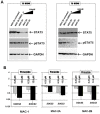t(8;9)(p22;p24)/PCM1-JAK2 activates SOCS2 and SOCS3 via STAT5
- PMID: 23372669
- PMCID: PMC3553112
- DOI: 10.1371/journal.pone.0053767
t(8;9)(p22;p24)/PCM1-JAK2 activates SOCS2 and SOCS3 via STAT5
Abstract
Fusions of the tyrosine kinase domain of JAK2 with multiple partners occur in leukemia/lymphoma where they reportedly promote JAK2-oligomerization and autonomous signalling, Affected entities are promising candidates for therapy with JAK2 signalling inhibitors. While JAK2-translocations occur in myeloid, B-cell and T-cell lymphoid neoplasms, our findings suggest their incidence among the last group is low. Here we describe the genomic, transcriptional and signalling characteristics of PCM1-JAK2 formed by t(8;9)(p22;p24) in a trio of cell lines established at indolent (MAC-1) and aggressive (MAC-2A/2B) phases of a cutaneous T-cell lymphoma (CTCL). To investigate signalling, PCM1-JAK2 was subjected to lentiviral knockdown which inhibited 7 top upregulated genes in t(8;9) cells, notably SOCS2/3. SOCS3, but not SOCS2, was also upregulated in a chronic eosinophilic leukemia bearing PCM1-JAK2, highlighting its role as a central signalling target of JAK2 translocation neoplasia. Conversely, expression of GATA3, a key T-cell developmental gene silenced in aggressive lymphoma cells, was partially restored by PCM1-JAK2 knockdown. Treatment with a selective JAK2 inhibitor (TG101348) to which MAC-1/2A/2B cells were conspicuously sensitive confirmed knockdown results and highlighted JAK2 as the active moiety. PCM1-JAK2 signalling required pSTAT5, supporting a general paradigm of STAT5 activation by JAK2 alterations in lymphoid malignancies. MAC-1/2A/2B--the first JAK2-translocation leukemia/lymphoma cell lines described--display conspicuous JAK/STAT signalling accompanied by T-cell developmental and autoimmune disease gene expression signatures, confirming their fitness as CTCL disease models. Our data support further investigation of SOCS2/3 as signalling effectors, prognostic indicators and potential therapeutic targets in cancers with JAK2 rearrangements.
Conflict of interest statement
Figures




Similar articles
-
The t(8;9)(p22;p24) is a recurrent abnormality in chronic and acute leukemia that fuses PCM1 to JAK2.Cancer Res. 2005 Apr 1;65(7):2662-7. doi: 10.1158/0008-5472.CAN-04-4263. Cancer Res. 2005. PMID: 15805263
-
Jak3, STAT3, and STAT5 inhibit expression of miR-22, a novel tumor suppressor microRNA, in cutaneous T-Cell lymphoma.Oncotarget. 2015 Aug 21;6(24):20555-69. doi: 10.18632/oncotarget.4111. Oncotarget. 2015. PMID: 26244872 Free PMC article.
-
The t(8;9)(p22;p24) translocation in atypical chronic myeloid leukaemia yields a new PCM1-JAK2 fusion gene.Oncogene. 2005 Nov 3;24(48):7248-52. doi: 10.1038/sj.onc.1208850. Oncogene. 2005. PMID: 16091753
-
Should myeloid and lymphoid neoplasms with PCM1-JAK2 and other rearrangements of JAK2 be recognized as specific entities?Br J Haematol. 2014 Sep;166(6):809-17. doi: 10.1111/bjh.12963. Epub 2014 Jun 10. Br J Haematol. 2014. PMID: 24913195 Review.
-
Cutaneous T-cell lymphoma: molecular and cytogenetic findings.Oncology (Williston Park). 2007 Feb;21(2 Suppl 1):13-7. Oncology (Williston Park). 2007. PMID: 17474354 Review.
Cited by
-
The diagnostic challenges and clinical course of a myeloid/lymphoid neoplasm with eosinophilia and ZBTB20-JAK2 gene fusion presenting as B-lymphoblastic leukemia.Cold Spring Harb Mol Case Stud. 2020 Apr 1;6(2):a004937. doi: 10.1101/mcs.a004937. Print 2020 Apr. Cold Spring Harb Mol Case Stud. 2020. PMID: 32238402 Free PMC article.
-
Primary cutaneous gamma/delta T-cell lymphoma with simultaneous JAK2 and TP63 rearrangements: a new double-hit?Histopathology. 2023 Sep;83(3):492-495. doi: 10.1111/his.14973. Epub 2023 Jun 12. Histopathology. 2023. PMID: 37308177 Free PMC article.
-
RNA Sequencing of Primary Cutaneous and Breast-Implant Associated Anaplastic Large Cell Lymphomas Reveals Infrequent Fusion Transcripts and Upregulation of PI3K/AKT Signaling via Neurotrophin Pathway Genes.Cancers (Basel). 2021 Dec 7;13(24):6174. doi: 10.3390/cancers13246174. Cancers (Basel). 2021. PMID: 34944796 Free PMC article.
-
Genomic Aberrations Generate Fusion Gene FOXK2::TP63 and Activate NFKB1 in Cutaneous T-Cell Lymphoma.Biomedicines. 2022 Aug 21;10(8):2038. doi: 10.3390/biomedicines10082038. Biomedicines. 2022. PMID: 36009586 Free PMC article.
-
Recurrent STAT3-JAK2 fusions in indolent T-cell lymphoproliferative disorder of the gastrointestinal tract.Blood. 2018 May 17;131(20):2262-2266. doi: 10.1182/blood-2018-01-830968. Epub 2018 Mar 28. Blood. 2018. PMID: 29592893 Free PMC article. No abstract available.
References
-
- Hoeller S, Walz C, Reiter A, Dirnhofer S, Tzankov A (2011) PCM1-JAK2-fusion: a potential treatment target in myelodysplastic-myeloproliferative and other hemato-lymphoid neoplasms. Expert Opin Ther Targets 15: 53–62. - PubMed
-
- Radtke S, Haan S, Jorissen A, Hermanns HM, Diefenbach S, et al. (2005) The Jak1 SH2 domain does not fulfill a classical SH2 function in Jak/STAT signaling but plays a structural role for receptor interaction and up-regulation of receptor surface expression. J Biol Chem 280: 25760–25768. - PubMed
Publication types
MeSH terms
Substances
Grants and funding
LinkOut - more resources
Full Text Sources
Other Literature Sources
Medical
Research Materials
Miscellaneous

